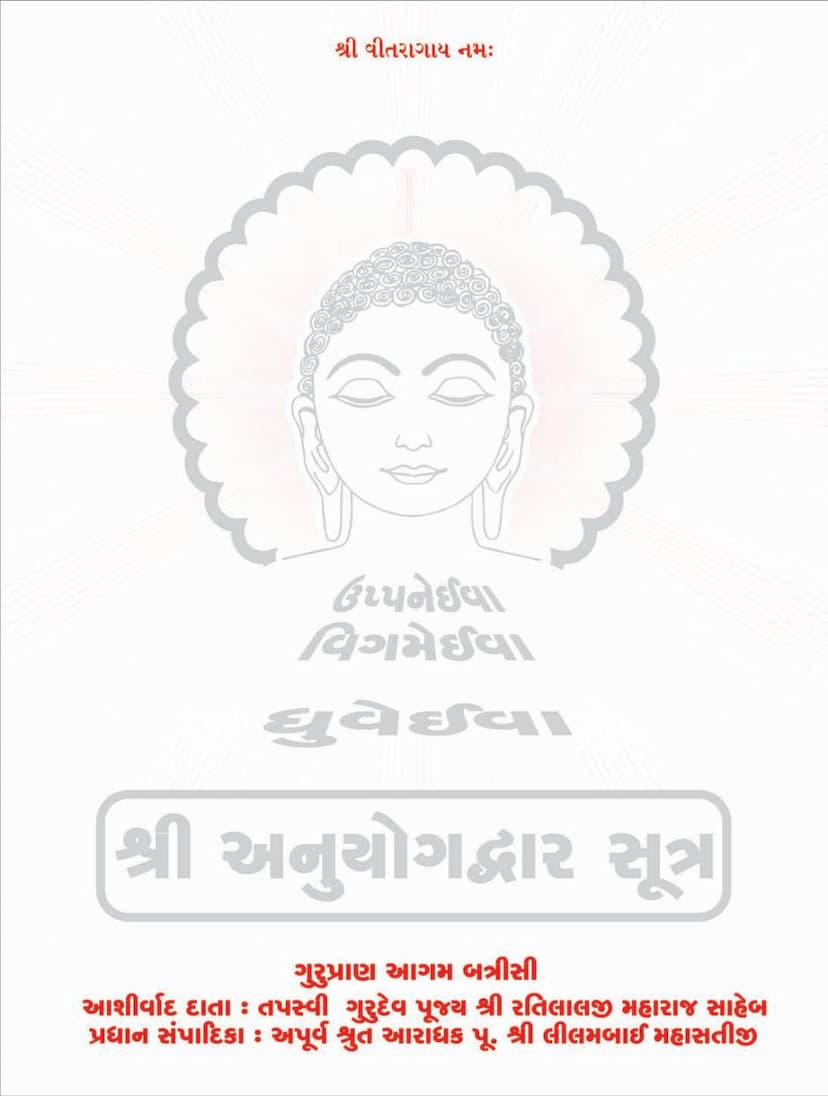Agam 32 Chulika 02 Anuyogdwar Sutra Sthanakvasi
Added to library: September 1, 2025

Summary
Here is a comprehensive summary of the Jain text "Agam 32 Chulika 02 Anuyogdwar Sutra Sthanakvasi" based on the provided text, presented in English:
Book Title: Agam 32 Chulika 02 Anuyogdwar Sutra Sthanakvasi Author(s): Subodhikabai Mahasati, Artibai Mahasati Publisher: Guru Pran Prakashan Mumbai
This extensive Jain text, the "Anuyogdwar Sutra," is presented as part of the "Guru Pran Agam Batrisi," a collection of 32 Agams, published by Guru Pran Prakashan, Mumbai. The text is dedicated to the memory of revered spiritual leaders, particularly Pujya Shri Pranalalji M. Sa. and the decade anniversary of the Mahaprayan of Tapasamrat Pujya Shri Ratilalji M. Sa. The publication is under the auspicious presence of Paramarshik Pujya Shri Jayantmuni M. Sa. and guided by Acharya Pravar Pujya Shri Girishmuniji M. Sa. and Agam Diwakar Pujya Shri Janakmuni M. Sa.
Core Content and Structure:
The Anuyogdwar Sutra, as presented in this publication, is a foundational text in Jain philosophy, particularly focusing on the classification and analysis of knowledge (Shrut) and the methods of inquiry (Anuyog). The text is structured around the concept of Anuyog Dwar, which can be understood as the "gateways" or "means of inquiry" to understand the vastness of Jain scriptures.
Key Concepts Explained:
The text meticulously breaks down and explains various aspects of Jain epistemology and metaphysics through a systematic approach. The core framework revolves around:
-
Naya (Standpoints): The text emphasizes the importance of understanding concepts from different standpoints. It discusses various nayas, particularly the seven nayas (Nigam, Sangrah, Vyavahar, Riju-sutra, Shabda, Samabhirudh, Evambhuta), which are crucial for understanding the multifaceted nature of reality according to Jainism. The example of "vasati" (residence) is used to illustrate how different nayas perceive the same concept differently, highlighting the relativistic nature of knowledge and the path to ultimate truth.
-
Nikshep (Classification): The text introduces and elaborates on the concept of Nikshep, which is a fundamental tool for classifying and understanding reality. It details the four Niksheps:
- Naam (Name): The conventional name given to a thing.
- Sthapana (Establishment/Representation): The representation of a thing through an image, symbol, or likeness.
- Dravya (Substance/Reality): The actual underlying substance or reality of a thing.
- Bhav (State/Condition): The current state or condition of a thing. The text meticulously applies these Niksheps to various concepts, including "Aavashyak" (essential duties), "Shrut" (scriptural knowledge), and "Skandh" (aggregates/combinations).
-
Anuyog (Modes of Inquiry): The text categorizes the ways of inquiry into four main Anuyogs:
- Dravyanuyog: The mode of inquiry focusing on the fundamental substances or realities.
- Charankarananuyog: The mode of inquiry focused on conduct, practice, and vows.
- Ganitanuyog: The mode of inquiry focused on calculations, mathematics, and cosmology.
- Dharmakathanuyog: The mode of inquiry focused on narratives, stories, and ethical teachings. The Anuyogdwar Sutra itself is shown to primarily align with Dravyanuyog, while also incorporating elements of the other Anuyogs.
-
Shrut (Scriptural Knowledge): The text clarifies the nature and classification of Shrut, which encompasses all scriptural knowledge. It is divided into Angapravishtha (canonical scriptures) and Angabahya (non-canonical scriptures). The text highlights the significance of understanding Shrut through various Anuyogs and Niksheps.
-
Upakram (Introduction/Starting Point): The text begins by explaining the six aspects of Upakram: Naam, Sthapana, Dravya, Kshetra, Kaal, and Bhav. These serve as the initial gateways to understanding a topic. The text then delves deeply into Aanupurvi (Sequential Order) as a significant aspect of Upakram, explaining its various types:
- Naam Aanupurvi: Sequential order of names.
- Sthapana Aanupurvi: Sequential order of representations.
- Dravya Aanupurvi: Sequential order of substances, including their permutations related to space (Kshetra) and time (Kaal).
- Kshetra Aanupurvi: Sequential order related to space.
- Kaal Aanupurvi: Sequential order related to time.
- Bhav Aanupurvi: Sequential order related to states or conditions. The text provides detailed examples and classifications for each, particularly for Dravya, Kshetra, and Kaal Aanupurvi, illustrating concepts with numerical sequences and logical progressions.
-
Bhav (States/Conditions): The text explores the concept of Bhav, categorizing them into six types: Audayik (due to karma eruption), Aupashamik (due to karma suppression), Kshāyik (due to karma destruction), Kshāyopashamik (due to karma eruption and suppression), Pārināmik (natural state), and Sānnipātik (combination of states). It further elaborates on these Bhavas with detailed examples.
-
Paramanu and Skandh: A significant portion of the text delves into the granular nature of reality, explaining Paramanu (the smallest indivisible particle) and Skandh (aggregates of Paramāṇus). It discusses their spatial relationships (pradesha) and how they form the basis of the physical universe.
-
Gati (Realms of Existence): The text provides detailed information on the lifespan (Aayushya Sthiti) of beings in the four realms of existence: Naraka (hellish beings), Tiryang (animals/sub-human beings), Manushya (humans), and Deva (celestial beings). It quantifies these lifespans in terms of palyopama and sagaropama, the vast units of time in Jain cosmology.
Key Features of the Publication:
- Comprehensive: The publication aims to provide a complete understanding of the Anuyogdwar Sutra, including its original text, word meanings, explanations, commentaries, and appendices.
- Devotional: The publication is framed with devotional salutations to the Jinas and spiritual preceptors, reflecting the reverence for the Agamas.
- Illustrative: The text uses numerous examples, particularly in explaining Nayas and the concept of Aanupurvi, to make complex philosophical ideas accessible.
- Scholarly: The text is presented with references to its importance in Jain literature and the lineage of its dissemination, highlighting the contributions of various spiritual masters.
Overall Significance:
The Anuyogdwar Sutra, as presented in this volume, is a testament to the depth and systematic nature of Jain logic and epistemology. It serves as a crucial text for understanding how Jain philosophy analyzes reality, knowledge, and spiritual progression through various logical frameworks like Nayas and Nikshepas. The text emphasizes a meticulous approach to understanding spiritual principles, breaking down complex concepts into understandable components. The publication itself is a dedicated effort to preserve and propagate this vital knowledge within the Jain tradition.